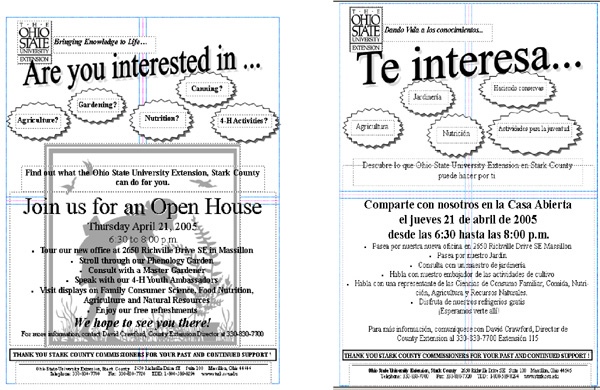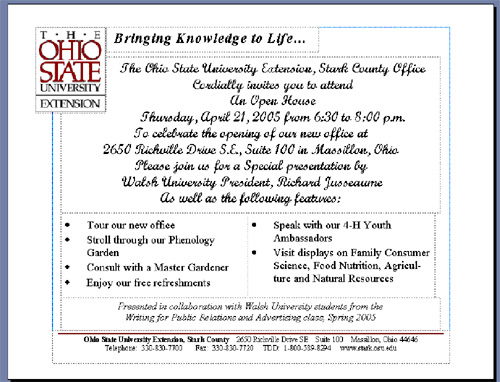April 2007 // Volume 45 // Number 2 // Ideas at Work // 2IAW1
Lessons Learned-Service Learning: A New Initiative in Field Experience and Collaboration between Universities, County Extension Offices and Communities
Abstract
Need to market your county Extension program in a professional, timely, and cost-effective manner? Service Leaning is a new teaching initiative between universities and communities. A Walsh University, North Canton, Ohio communications class embraced service leaning in a collaborative effort with Ohio State University Extension, Stark County. Results were a successful class, with hands-on experience for students, and a low-cost and effective public relations and advertising campaign for OSU Extension, Stark County. This article highlights lessons learned while exploring the project framework as well as potential rewards for the involved service learning project partners.
Introduction
"We need to market our Extension programs. . . . We don't have a budget for developing a marketing plan let alone costs of printing. . . . Who do we market to? . . . What do we market? . . . Help!!" Does this sound familiar in county Extension offices across the United States? Try a community service learning project with a local university partner.
The Class
Service learning is a combination of classroom concepts, student reflection, and hands-on learning with a service learning partner. In the public relation writing and advertising class at Walsh University, North Canton, Ohio, the service learning component was a perfect combination of field experience combined with classroom instruction. This collaboration was a win-win situation for students and the community partner. Students learned under the direction of a professor and received hands-on experience. The community service partner acquired low-cost professional work and participated in a rewarding experience of mentoring students. Service learning teaches students that communities need to be nurtured to survive.
Public Relations students developed a portfolio and worked with a partner. Team and individual student assignments were added to build the partner's campaign. Students "learned by doing," but learning by thinking about what they are doing enhances their ability for success. Professional portfolios were prepared by students and reviewed by marketing professionals. It is important to remember that the assignments are graded, not the service.
The Partner
Ohio State University Extension, Stark County had become an independent county Extension office. Stark and Summit counties combined resources to form a county Extension office for 13 years. Unrealistic programming goals, low funding, and reduced staffing contributed to the need for becoming independent. After much research, planning and negotiations, a plan to move forward as part of a USDA Service Center, new facility, new partnerships, and a presence in a new location in Stark County became a reality. The challenge was, "How do we get the word out about the best kept secret in the county--Extension."
The Collaboration
The service partner, the professor, and the class should go into the collaboration with high expectations. Prospective partners need to be educated on how service learning works. The class needs to be involved from the beginning. The proposal for the service partner should come from class research. The service partner must know that service learning is collaboration among the class, the professor, and the partner.
A good service partner must make the commitment to be available to work around the class schedule. A partner must be available after hours and to commit to the project from the start. The best approach is for the partner, professor, and a group of students to define the objectives and parameters of the project. A contract should be in place. This ensures that the service partner is not disappointed in the project at its conclusion and that students feel their project is a priority.
The Project
The project goals were to raise awareness of the OSU Extension, Stark County programs, and its new facility and to help increase funding. Another goal was to create branding of OSU Extension, Stark County, while developing Extension marketing materials for staff and volunteers
The class researched the partner's organization to determine challenges and opportunities. The students then formed teams and created campaign proposals that were presented to the partner. The partner and professor selected the best ideas for the campaign.
Assignments
There was no grade for service. Students were graded on completed assignments in both individual and team efforts. The most effective individual work included an appeal letter to sponsors, press releases announcing Extension's Open House, bookmarks (Figure 1), Flyers (Figure 2), and writing reflective journals.
Figure 1.
Bookmark

Figure 2.
Flyer in English and Spanish

Team efforts resulted in several products, including an invitation card (Figure 3), a PowerPoint presentation, displays, Stark County Media Guide, brochure, Hispanic Outreach and Urban Push, along with a Final Report <http://www.walsh.edu/pdf/ServiceLee.pdf>. Several students also presented to a state representative and university officials during a biennial session.
Figure 3.
Invitation

Measurable results of the project included an Open House, attended by 350 individuals. Team members were recruited for a segment on a local cable channel. Extension received 25 inquiries about programs and services. The Hispanic and urban populations have become more aware of Extension and its programs. In addition, two urban youth centers requested collaborative programming.
Strengths of the Project for Students
Major strengths for the students were excellent communication between professor, class, and partner. Timely responses on assignments from the service partner were required, and students learned to work under deadlines. Students improved technology skills as projects were graded and returned electronically. Students developed delegation, organization, and strategy skills among themselves. Although the class became competitive, students respected one another's opinion, and many students became empowered and emerged as leaders. Confidence levels were raised as students offered opinions and began to express themselves. Published pieces were placed in portfolios enhancing employment opportunities. The project generated great interest from the communication industry as demonstrated by their participation and mentorship.
Limitations of This Approach
Although many positive outcomes were experienced, the partners became aware of limitations. Some included students who only wanted to do what was being graded in the class. There were team breakdowns and conflicts early on. One student had some personal problems, and there was a lack of team leadership. Another limitation was the unexpected project costs for the partner, which included printing, postage, supplies, and refreshments. The partner's staff was initially skeptical, but supported the project after coaching.
Summary
Service learning is a rewarding experience for students, faculty, and partners. The partner was able to help educate the class and mentor students. Students involved in service learning became aware of their responsibilities within the community while learning about their profession. Extension has benefited greatly by utilizing concepts and materials developed for local promotion and programming efforts.
